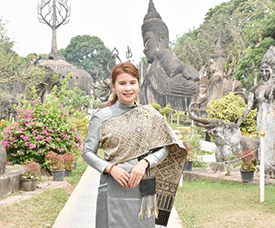Buddha Park gets a facelift for Laos-China tourism year

Since the government announced 2019 as Visit Laos-China Year, many businesses have taken steps to ensure they will be as welcoming to Chinese visitors as possible.
This includes the Xiengkhouan Cultural Park Company (XCPC), which is renovating the popular park with the aim of providing a satisfying experience for everyone who steps through its gates.
The concessionaire who is making the changes to the park, Ms Soysuda Inmungsay, said the whole development is expected to take five years.
“I am very happy to be improving the Xiengkhouan Cultural Park,” she said. Ms Soysuda, who is President of the Xiengkhouan Cultural Park Company, said the park is on its way to becoming a site of cultural importance in Hadxaifong district.
With a 40 billion kip investment in the project, XCPC has been granted a 30-year concession lease to restructure the 21,000-square-metre site.
Ms Soysuda said the improvements envisioned for the park will make it more appealing to tourists with vastly better facilities. Some 22 closed-circuit television cameras will also be installed.
The park is currently undergoing renovation by another concession holder to give it a facelift for Visit Laos-China Year 2019.
The work began in August 2017 and the first phase was completed last year, during Visit Laos Year 2018.
A new paved pathway has since been built, colourful flowers have been planted and 18 toilets have been installed. A metre-high wall has also been constructed which partitions the restaurant from the gift shop and the main park where the statues are situated.
Soon, there will also be a grassy area and a children’s playground. The main gate is being rebuilt and is expected to be finished by the end of this year.
In addition, the company plans to construct a concrete embankment along the Mekong River where the park is located. Once this embankment is in place, it will provide a fantastic vantage point from which to view life on the river and across to Nong Khai province in Thailand, which lies opposite the Xiengkhouan Cultural Park.
Along the wall 60 Buddha images have been built. It is envisaged that devotees will come to worship at the park on religious occasions.
The area around the restaurant behind the park will also be extended to give visitors an expansive view over the Mekong while they enjoy a meal. For Visit Laos-China Year 2019, Ms Soysuda has prepared a menu of Chinese dishes and earphone translations in to Chinese, describing many of the park’s structures.
The number of people visiting the park is increasing, Ms Soysuda said with visitor numbers of about 800 people per day.
This is an increase of 40 percent compared to the same period in 2017 when the company began its concession. Most visitors to the park come from the Republic of Korea, China, Vietnam, France, Australia, Thailand and Laos.
Ms Robyn Cassidy, a visitor from Australia, said this was the first time she had been to the park and found it quite amazing. She had never been anywhere quite like it before and said the climb to the top of the dome that offers views over the park was very impressive.
This dome is one of the many enigmatic structures in the park and one of the first you encounter when you enter.
It is a three-story spherical building that has the gaping mouth of a demon as its entrance. Visitors who venture in can then climb a series of staircases that lead out of the hell from which they have entered. While earth sits at the centre of the dome, heaven awaits those who get to the top. The view over the park and its 300 Buddhist and Hindu statues is spectacular and a great place to take a photo.
The Buddha Park was put together in 1958 by a priest-shaman named Bounleua Soulilath. Although the enormous stone statues appear to be centuries old and are extremely photogenic, most are actually less than 60 years old and were carved on the ground where they now sit.
The park charges 10,000 kip for Lao citizens and 15,000 kip for foreigners. Children are admitted free of charge. The park is open from 8am to 5pm every day.
Editor: John Li